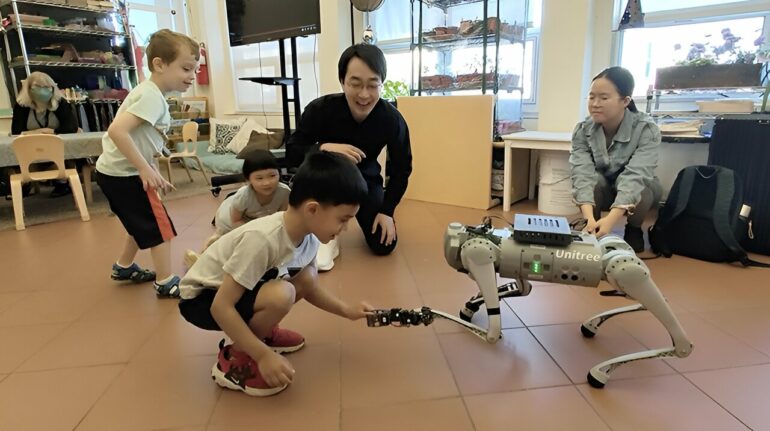Parents spend roughly 300 hours each year cleaning up after their kids. That’s nearly two weeks that could be otherwise spent doing anything else. Researchers in Carnegie Mellon University’s Department of Mechanical Engineering, in collaboration with Google DeepMind and University of Washington, are hopeful that parents will regain tidying time and then some with LocoMan, a four-legged version of the Jetsons’ beloved maid “Rosie the Robot,” that could lend a hand in the not-so-distant future.
Quadrupedal robots, designed to move on four legs much like a dog, are already leading search and rescue missions, surveying construction sites, and moving parts around factories. Their ability to navigate complex environments with a low center of gravity and light weight make quadrupedal robots a top contender for household use. Until now, the missing piece was the dexterity and versatility skills necessary for them to be efficient in daily life.
By installing two custom-designed, lightweight manipulators (think robot arms) onto the front legs of a quadrupedal robot, Ding Zhao has created a robot versatile enough to open doors, pour drinks, plug a phone in to charge, and perhaps best of all—clean up after your on-the-go toddlers.
“While many work on humanoid robots that look like humans, with potential to directly learn from humans or even replace humans in some tasks, we focus on robots that are complementary to humans to team up with them,” said Zhao, associate professor of mechanical engineering.
Unlike humanoid robots that come at a high cost and hefty weight, Zhao’s manipulators can be added to existing lower-cost quadrupedal robots and are compact, lightweight, and easy to fabricate making them an accessible technology.
“We used four commercially available servos and 3D printed a few other parts to bring them to life,” explained Changyi Lin, a Ph.D. candidate in CMU Safe AI Lab and a co-author of a paper on this topic.
Zhao’s team introduced the robot to a class of preschool students at The Cyert Center for Early Education of Carnegie Mellon University. After explaining to children how robots work and what we use them for, the children had the opportunity to interact with Zhao’s robot. The students were impressed with the robot’s capabilities and didn’t want it to leave their classroom.
The group continues to develop LocoMan to perform tasks autonomously by integrating advanced perception and intelligence planning capabilities into its existing whole-body controller.
“We anticipate that robots like LocoMan will be ready to help out at home, or in daycares, within the next three years,” said Zhao. “It is a pleasant job just to imagine that I may no longer need to handle my kids’ messy fun.”
This work will be presented at the loco-manipulation workshop and the manipulation skills workshop of the 2024 IEEE International Conference on Robotics and Automation.
Provided by
Carnegie Mellon University Mechanical Engineering
Citation:
Manipulation technology makes home-helper robot possible (2024, May 13)



